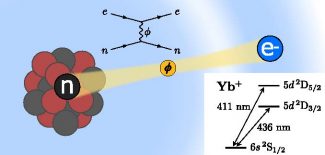News
Searching for new boson with isotope shift spectroscopy
Dark matter is one of the main unknowns in our understanding of the universe. There are numerous types and classes of candidates for dark matter. Light-force carriers may be exciting candidates given their potential for displaying intra-atomic forces that may be probed with precision atomic spectroscopy. They are so-far-unknown elementary bosons that may carry mass and readily couple to usual types of matter such as electrons and neutrons. The couplings lead to tiny additional forces between electrons and neutrons in atoms and slightly perturb transition frequencies between energy levels in the atoms.
Direct measurement of the dark-boson shift involves both experimental measurement and theoretical calculation of the atomic transition frequency with high precision. While there was an unprecedented evolution of the precision of atomic physics experiments, it is not yet feasible to perform the calculation with a precision that is comparable to experiments. Fortunately, there have been proposals to circumvent this problem while still searching for dark matter [1-3]: measuring isotope shifts for at least four isotopes with even atomic mass number (A) and more than two transitions. If the measured isotope shifts are mapped in a 2-D graph called King plot, all points should be on a single line, predicted by the Standard Model. Testing the linearity comes down to solely experimental work and does not require the calculation with unreasonably high precision. The requirements in the experiment make singly ionized Ytterbium (Yb+) one of the preferred species among ion trapper’s usual choices because Yb has five stable even-A isotopes and three narrow transitions known so far.

Image Caption: Dark bosons (φ) interacts with neutrons (n) and electrons (e) and creates forces between them inside atoms. The force may be probed by measuring isotope shifts of the two optical transitions in Ytterbium ions.
A group at MIT led by Vladan Vuletić has recently completed first-round experiments on measuring isotope shifts with high precision using a single trapped Yb+. They loaded and laser-cooled an Yb+ ion, one isotope at a time, in an electrical ion trap. The Isotope shifts for all five stable even-A isotopes and two optical clock transitions were measured with ~300 Hz precision. The isotope shifts mapped in a King plot showed the departure from the linearity with its significance approaching 3.5 standard deviations. The non-linearity could have originated from either dark-boson coupling, higher-order corrections in Standard Model, or both. Having five isotopes rather than four gave some hints about the source of non-linearity.
Regarding future work, isotope-shift measurements for another transition will provide more evidence about the source of the non-linearity. The precision will be also increased, possibly 1000 times better, by reducing noise and drift in the experimental setup, co-trapping two ions of different isotopes, or employing entanglement between them.
This work will contribute to the dark-matter search as potential indirect evidence of a dark boson. It may also support other observations such as X17 bosons from 8Be nuclear decay [4] and motivate the community to narrow down their efforts to the specific dark-matter candidates.
[1] J. C. Berengut et al., PRL 120, 091801 (2018)
[2] V. V. Flambaum, A. J. Geddes, and A. V. Viatkina, PRA 97, 032510 (2018)
[3] K. Mikami, M. Tanaka, and Y. Yamamoto, Eur. Phys. J. C 77, 896 (2017)
[4] A. J. Krasznahorkay et al., arXiv:1910.10459 [nucl-ex]
